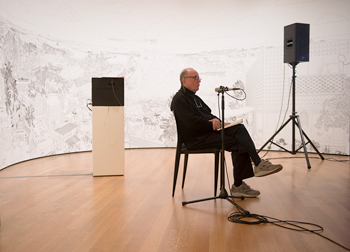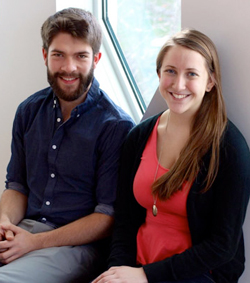by Mike Telin

On Friday, February 19 at 7:00, a near-capacity crowd gathered in the church’s sanctuary to participate in, and listen to, the Syndicate’s own rendition of Alvin Lucier’s classic of minimal tape music, I am Sitting in a Room.
First performed in 1969, the work featured Lucier recording himself reciting this text:
I am sitting in a room, different from the one you are in now. I am recording the sound of my speaking voice and I’m going to play it back into the room again and again until any semblance of my speech with perhaps the exception of rhythm is destroyed. What you will hear, then, are the natural resonant frequencies of the room articulated by speech. I regard this activity not so much as a demonstration of a physical fact, but more as a way to smooth out any irregularities my speech might have.
The recording was then played back into the room and re-recorded, a process that was repeated until the words became unintelligible and were gradually replaced by the pure harmonies of the space.
At this performance the audience recited the minute-long text, and after a brief pause while engineer John Burnett prepared the electronics, at 7:28 pm, the first presentation of the recording was played with the recitation clearly audible. The number of re-recordings it takes for the text to become unintelligible depends on the size and shape of the room. In this case, during the third loop at 7:31 the text could still be understood. However during the fourth loop the text became faint and by the fifth loop had morphed into a “ma-ma-ma.”
By 7:40 “ma-ma-ma” had become “wa-wa-wa” and what could be described as “sound tails” began to develop between the end of one loop and the beginning of the next. By 7:45 the sounds had taken on a mystical quality, and by 7:48 the sound tails had all but disappeared — the breaks between loops no longer existed. By 7:52 the sound became noticeably flatter, like a clarinetist practicing long tones with breath accents. By 8:05 only the slightest accents could be detected, and by 8:08 the sound was completely flat. At 8:10 the process came to an end.
All in all, it was a fascinating listening exercise that became the impetus for conversation amongst audience members who didn’t appear to want to leave.

Performing under the name Second Species, Hammel and Roidl-Ward, both recent graduates of the Oberlin Conservatory and currently doing graduate work at Rice University, have obviously been well-trained in contemporary music performance practices. By the concert’s end, you wandered if there was anything either musician was not capable of doing. The duo’s program offered a broad spectrum of musical styles, from the radical avant-garde to the more traditional. Their ability to make a plethora of extended techniques sound like second nature was astonishing.
Theo Chandler’s Seven Pieces (2015) for flute and bassoon is a skillfully written work that plays to the strengths of both instruments. Throughout the seven movements, Chandler takes the listener on a roller coaster ride full of catchy rhythms and melodic passages. His use of echoed accents between the instruments in No. 5 is inspired, and Roidl-Ward and Hammel’s technically dazzling performance of No. 7’s jazzy perpetual motion brought the work to a rousing conclusion. It will be interesting to hear more of Chandler’s music in the future.
Jessie Limbacher’s Enlaced (2016) for flute and bassoon, a work in A-B-A form, utilizes long unison sections. Here the players’ blend was seamless. The B section’s fast, overlapping single-note staccato rhythms quickly return to the alluring A section.
Daria Tennikova-Satral’s Mythical Maze (2015) for solo flute evokes the challenge of finding your way out of a maze. The work’s quick character changes musically portray someone running until exhaustion sets in. Hammel perfectly captured the essence of the piece.
The eerie, grotesque sonorities in Kurt Isaacson’s carnal species conjured up images of the Mesozoic Era when dinosaurs freely roamed the earth. Multiphonics, tongue slaps, hammered staccatos and long silences characterize the work and Hammel and Roidl-Ward gave it their all.
Roidl-Ward outdid himself during Chris Fischer-Lochhead’s grandFather (2012-13) for solo bassoon. Full of sliding multiphonics, flutter-tonguing, quick shifts from rapid scale passages to vocalizing growls and yelps and back again, the piece is best described as grandpa gone wild. And Roidl-Ward’s astonishing performance left you wondering, ‘how did he do that?’
Peter Kramer’s Caccia (2016) for flute and bassoon utilizes, as the title suggests, the Renaissance musical form where two voices chase each other in canon and in unison. Beginning with air sounds in the flute, the piece soon becomes fast-paced as the two lines chase each other. The score extended across numerous music stands, which necessitated the use of a page turner, and watching the choreography unfold only added to the listening pleasure.
The evening concluded with Rob Hutchinson’s Sittin’ In A Tree (2016) for flute and bassoon. The composer’s background in jazz and bebop was evident as he deftly wove together a medley of jazz standard love songs like Misty and Cheek to Cheek. The duo’s spritely performance brought the concert to a fine conclusion.
Published on ClevelandClassical.com March 30, 2016.
Click here for a printable copy of this article

